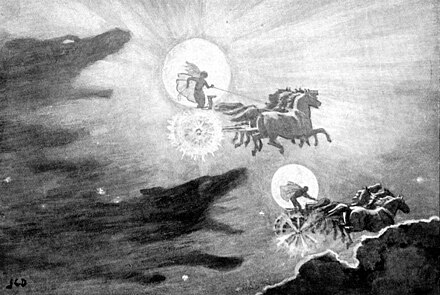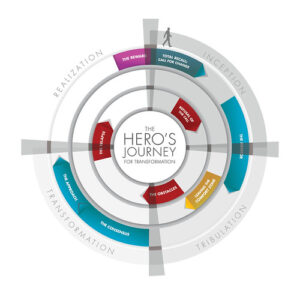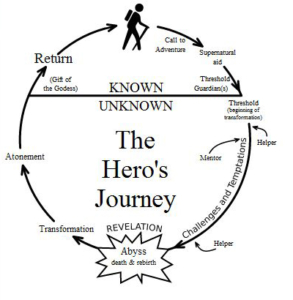Hero’s Journey: Create Your Personal Myth.

Summary
Do you hope your life is like an adventure?
Do you feel that your life is stuck in the same predicament over and over again?
If you have these questions, then this toolkit invites you to embark on a personal hero's journey.
Finally, you will find that what you fear is not an external enemy, but the self that has yet to be understood.
This OER toolkit aims to provide a mental map for learners. It guides learners to complete a simple hero's journey within 20 minutes, from the call to adventure, trials, to the return.
Here, you don't need any literary experience. With just a pen, a piece of paper, and a bit of imagination, you can construct a complete personal hero journey.
In the cave you fear to enter lies the treasure you seek.
— Joseph Campbell
Declaration:
This toolkit aims to support psychological reflection through an artistic approach.
It is not psychotherapy but a form of self-observation and creative practice.
If you feel uncomfortable during the process, please stop it or seek support.
Required materials:
- A piece of paper or a digital document for writing or drawing
- A timer (about 2-3 minutes per step)
- A quiet space to thinking
- You can prepare a piece of music that can help you get into the mood
Now, take a deep breath –
Your hero’s journey is going to begin.
Process:
♦Step 1: Hear the Call of Life
Every adventure begins at a moment of imbalance:
Joseph Campbell, who is the master of mythology, once said, “Every crisis is a call from the gods.”
Exercises:
Write down the challenge which you are currently facing and avoiding, or a change you truly desire.
It could be external pressure- such as “I’m afraid I won’t do well on this exam.” “I want to apply for a master’s degree abroad, but I don’t know where to start.”
Or it could be an internal unease – such as “I’m afraid others will see through the real me.” “I want to try, but I don’t think I’m good enough.”

The New Heros Journey
license:free to share and use
When you think about these questions, congratulations, Hermes(the messenger in Greek mythology)has already handed you the letter, and you have qualified to enter the dark forest. A great adventure is about to begin.
♣Step Two: Crossing the Threshold
When faced with a call to adventure, our instinct is often to retreat. This is the first obstacle on your hero’s journey. It’s not the ultimate challenge, but your “threshold guardian” needs to ensure you’re ready.
Exercises:
1.Write down why you resist facing this problem.
You might think, “I’m not ready. I don’t have time.” “This is too complicated. I can’t do it.”
These voices that make us retreat are called “threshold guardians.” They ensure you stay in your comfort zone but also prevent you from entering new territory. Psychology calls this a “defense mechanism.”
2.Be honest about your fears and hesitations.
For example: “I tell myself I don’t have time, but I’m really avoiding it.” “I say I don’t need this because I’m afraid I won’t be able to achieve it.” “
In mythological tales, such moments often arise.

Theseus and the Minotaur loreandlegends.net
license:free to share and use
When Odysseus was summoned to set sail, he too wished to remain in Ithaca;
When Hercules was commanded to face the Twelve Labors, he too doubted his own strength;
Before Buddha attained enlightenment beneath the Bodhi tree, he too considered returning to the palace;
None of them were born heroes.
They were just ordinary people – hesitating, retreating, and resisting in the face of the call,
until at some point, they chose to move forward.
♠Step Three: Find the Guardian
Once you have crossed the starting threshold, you need a mentor to guide you. Your mentor doesn’t have to be a real person in the flesh; it could be:
- A real-life figure (a teacher, a friend, a family member)
- A character from a book or film (Yoda, Gandalf, Athena)
- Your inner self (your ideal self)
- An abstract symbol (a color, an object, a piece of music, a phrase)
Exercises:

Telemachus and Mentor
license:free to share and use
1.Imagine your mentor: Visualize the image, attitude, and personality of this mentor in your mind.
If you can’t concretize it for the moment, that’s fine. As long as you feel the energy of support, encouragement, and guidance, it’s enough.
2.Get your amulet: Imagine a phrase your mentor says to you and write it down.
If you prefer an abstract form, you can draw a symbol or use a color instead. This will become your amulet when facing the abyss.
3.Reflect on the meaning of your mentor: Think about why you chose this mentor? Does it reflect some unexpressed desire or strength within you?
Sometimes, your mentor is a part of you, reminding you that you already have the ability, but you just haven’t realized it yet.
♦Step Four: The Abyss and Revelation
Now that you have fully crossed the threshold and received your mentor’s amulet, you are about to face the true challenge – the dragon in the abyss.
(You can play a piece of music that holds significance to you here (such as a movie score) to help you get into the “adventure” mood.)
This dragon represents the people, events, and things that stand in your way on your hero’s journey. Sometimes, they even threaten your survival or affect your relationships with important people in your life (parents, lovers, friends).
Exercise;
1.Write down the people, events, or things that hinder your progress (“dragons”)
— For example: “My boss always criticizes me, making me doubt my abilities.” “Every time I have to give a public speech, I get so nervous that I can’t speak.”
2.Describe the emotions these dragons bring you: fear, anxiety, powerlessness, anger, sadness (remember, the emotional signals triggered by these dragons are the core of the abyss)
3.Identify the frequency and scenarios in which these emotions occur: Consider whether this emotion frequently appears in your life. Many of your problems actually stem from this emotion rather than the event itself.

Mount Olympus: Place Of The Gods Of Greek Mythology
license:free to share and use
As Campbell pointed out: “At first, you might think this dragon comes from the external environment and is against you, but the hero’s journey will help you realize that this demon does not come from the outside but exists within you.”
In other words, the dragon is the self we see in the mirror. It presents our inner shadow
— A part of our emotions that we have not yet learned how to face or integrate.
4.The hero chooses to confront it — not resist it, but understand it.
you must also learn to confront your shadow.
For each dragon, please write a sentence to respond to it.
For example:
“I feel anxious, which actually means I think I can do better.”
“I feel nervous, which shows that I value this matter.”
“I feel scared, and that’s normal. I allow myself to be scared.”
In this way, you transform the “dragon” from a mere obstacle into a prompt for inner strength.
You begin to understand: fear, anxiety, and tension are not enemies, but signals from life, guiding you to be clearer about your value and goals.
Step 5: Transformation and Return
Now that you have embraced the dragon, it’s time to prepare for the return journey.
Campbell calls this “the return with the Holy Grail” — what the hero brings back is not a trophy, but a new consciousness.
Exercise:
1.Review your journey: What gifts have you received? (Is it a courage, a sense of peace, or a belief that belongs to you?) Have you seen a part of the “hero” within yourself? Has this “awakening” changed the way you view yourself?
2.Symbolic Return: Visualize your gift —
Choose a symbolic form: You can choose a form to materialize your gift,
such as:
Image/Painting: Draw the image of your inner hero, a symbol, or a simple color
Text/Writing: Write a letter to your
Physical symbol: Select a small object (stone, accessory, plant, etc.) to represent your growth
3.Bring Insights into Life: Consider how you can apply this gift in your daily life (daily choices, interpersonal relationships, work and study). You can choose to share it with your companions around you.
Conclusion:
“Writing one’s own hero’s journey” is a profound process of psychological integration. As Frankl put it, meaning comes from three experiences: creation,
relationship, and attitude.

Story Design (Freytag’s Pyramid)
license:free to share and use
When we reshape meaning through writing, we are creating.
When we engage in dialogue with ourselves, others, and mentors, we are building relationships.
And when we choose a positive understanding despite pain, we are establishing an attitude.
Campbell said in “The Power of Myth”: “Heaven and hell are within us.”
Each time we choose to face fear, embrace the unknown, and take on the responsibility of creation, it is a journey “from hell to heaven.”
Within the framework of the hero’s journey,
every learner can realize that they are not victims of fate but authors of their own stories.
The Hero’s Journey Toolkit: Creating Your Own Personal Myth © 2025 by Yujia Wang is licensed under CC BY 4.0
Additional Reading:
- Frankl, Viktor E.Man’s Search for Meaning. Vienna: Franz Deuticke, 1946.
- Campbell, Joseph.The Hero with a Thousand Faces. New York: Pantheon Books, 1949.
- Gilligan, Stephen, and Robert Dilts.The Hero’s Journey: A Voyage of Self Discovery. Carmarthen: Crown House Publishing, 2010.
- Campbell, Joseph, and Bill Moyers.The Power of Myth. New York: Doubleday, 1988.
- Miller, Donald.Hero on a Mission: A Path to a Meaningful Life. Colorado Springs: WaterBrook, 2022.
- Nichols, Kevin P., and Chesnut, Donald. 2014.UX for Dummies. Newark: John Wiley & Sons, Incorporated. Accessed November 10, 2025. ProQuest Ebook Central.
- Ellis, Carolyn.The Ethnographic I : A Methodological Novel about Autoethnography. Walnut Creek, Calif. ; AltaMira Press, 2004. Print.
- Bochner, Arthur P, and Carolyn Ellis. “An Introduction to the Arts and Narrative Research: Art as Inquiry.”Qualitative inquiry 4 (2003): 506–514. Web.


